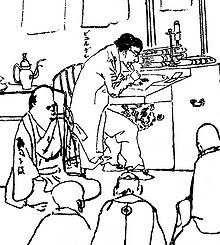Heinrich Bürger

Heinrich Bürger also: Heinrich Burger (born February 29 or November 7, 1804 or January 20, 1806 , Hameln ; † March 25, 1858 in Indramaju ( Java )) was a German pharmacist, natural scientist and chemist . Its official botanical author's abbreviation is " Bürger ".
It was of great importance for the study of the Japanese fauna and flora .
youth
The exact date of birth of the citizen is not known. He himself named February 29, 1804. The year mentioned in most sources is 1806. It appears that Heinrich moved his date of birth two years forward to be older. Bürger came from a Jewish family. His father, who was a merchant and protective Jew in Hameln (Kingdom of Hanover), went bankrupt in 1817 and died in 1821. He left a wife, two sons and seven daughters.
Heinrich studied mathematics and astronomy at the University of Göttingen around 1821-1822. Although he occasionally had a doctorate, an academic doctorate cannot be found. In 1824 Bürger traveled to Batavia in what was then the Dutch East Indies (now Jakarta ), where he attended the pharmacy school. On January 14, 1825, he was appointed third class pharmacist.
Dejima
On June 14, 1825, Heinrich Bürger was appointed assistant to Philipp Franz von Siebold by the Dutch government for the natural history research on the island of Dejima (Nagasaki, Japan). On July 1, he left for Japan. On Dejima, citizens made examinations in the chemical, natural history and biological areas and taught them to the Japanese. He then became head of pharmacy and assisted in Siebold's outpatient treatments for patients outside Dejima. In 1828, Bürger was appointed Siebolds' successor for chemical, natural history and biological work. Over the next few years he collected large collections of plants and animals, including 650 fish.
Much of this material was later used in the publication Fauna Japonica by Temminck and Schlegel . The plants collected by citizens found their way into the academic botanical gardens of the world and descendants can still be seen in the universities of Leiden , Brussels , Florence , Munich , St. Louis , Paris and London . The Naturalis Museum of Natural History in Leiden also has a large collection of citizens. Although Bürger appears in the IPNI , he has not described any new plants. The Imperial Herbarium in Leiden, however, has a manuscript from Bürger that contains a systematic listing of 1790 Japanese plants, mostly with Latin and Japanese names attached. It is therefore not surprising that at least 20 species of Japanese plants have an epithet that honors Heinrich Bürger, such as Buergerianum or Burgeri (i) .
Padang
In 1833 Bürger was appointed a member of the official commission for natural history research in East India . In this role he visited Sumatra between June and December 1833 and built a path from Padang on the west coast to the hinterland. It is the still existing path through the Anei Gorge, which is visited by many tourists because of its picturesque location. Because of the building, Bürger was made a Knight of the Order of the Dutch Lion in 1834. In 1833 Bürger married Anna Cornelia van Daalen in Padang. In 1834 he was back on Dejima, but his wife lived in Batavia.
Entrepreneur
With effect from July 1, 1835, Bürger was honorably relieved of his duties in Japan. He now received a monthly pension ( waiting allowance ) and settled in Batavia . In the years 1840–1842 he made an extensive trip through Western Europe with his family. Back in Java, Bürger retired in 1842 as a member of the Natural History Commission. On June 30, 1843 he was honorably discharged from civil service.
Citizen now made a career in business. In 1851 he was named as a supplier of rice and oil to the island of Bangka , from 1852 as a board member of the Dutch-Indian Society for Marine Insurance, from 1853 as one of the directors of a hard coal mining company, from 1855 as a sugar planter (together with Andreas Heijerdahl and Baron von Lützow) on the Redjosari plantation (Magettan, Madiun), in 1857 as the owner of a rice mill in Modjokerto and in 1858 a rice mill in Tjirebon, all on Java. He was also a board member of the most distinguished club on Java, the Harmonie Club in Batavia , from 1849-1852 . In 1855 Citizen got Dutch citizenship . He died in 1858 while on an inspection tour of his properties in Indramaju.
literature
- M. Boeseman: Revision of the fishes collected by Burger and von Siebold in Japan in: Zoologische Mededelingen, Tl. 28, 1947, pp. 1-242
- PM Kernkamp, Heinrich Bürger (Hamelen 1804/1806 - Indramajoe 1858) en zijn Duitse en Nederlandse familie , in: De Nederlandsche Leeuw 132 (2015) 108–132.
- J. Mac Lean, Natural science in Japan from 1828-1849 , in Janus LXII (1975), pp. 51-78
- MJ van Steenis-Kruseman: Heinrich Bürger (? 1806-1858), explorer in Japan and Sumatra , in: Blumea Jg. 11, Nr. 2, 1962
Web links
- Author entry and list of the described plant names for Heinrich Bürger at the IPNI
| personal data | |
|---|---|
| SURNAME | Citizen, Heinrich |
| ALTERNATIVE NAMES | Burger, Heinrich |
| BRIEF DESCRIPTION | German physicist, natural scientist and biologist |
| DATE OF BIRTH | February 29, 1804 or November 7, 1804 or January 20, 1806 |
| PLACE OF BIRTH | Hamelin |
| DATE OF DEATH | March 25, 1858 |
| Place of death | Java |